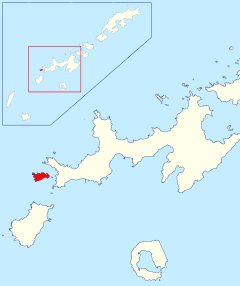Rugged Island: Difference between revisions
Created page with "{{Infobox island |name=Rugged Island |territory=British Antarctic Territory |group=South Shetland Islands |picture=Livingston-Greenwich-map.jpg |picture caption=Rugged Island ..." |
|||
| (2 intermediate revisions by the same user not shown) | |||
| Line 3: | Line 3: | ||
|territory=British Antarctic Territory | |territory=British Antarctic Territory | ||
|group=South Shetland Islands | |group=South Shetland Islands | ||
|picture= | |picture= | ||
|picture caption= | |picture caption= | ||
|map=Rugged | |map=Rugged Island (zoom), South Shetland Islands, BAT.svg | ||
|map caption=Rugged Island in the South Shetland Islands | |map caption=Rugged Island in the South Shetland Islands | ||
|latitude=-62.633 | |latitude=-62.633 | ||
|longitude=-61.25 | |longitude=-61.25 | ||
|area= | |area=4 square miles | ||
|highest height= | |highest height=840 feet | ||
}} | }} | ||
'''Rugged Island''' is an island | '''Rugged Island''' is an island three miles long and a mile wide in the [[South Shetland Islands]], within the [[British Antarctic Territory]]. It lies west of [[Livingston Island]]. | ||
The surface area is | The surface area is four square miles. The island's summit rises to 830 feet above sea level. | ||
Rugged Island was known to both British and American sealers as early as 1820, and the name has been well established in international usage for over 100 years. | Rugged Island was known to both British and American sealers as early as 1820, and the name has been well established in international usage for over 100 years. | ||
Rugged Island was first visited in 1819 by the sealing vessel ''Espirito Santo'' chartered by British merchants in Buenos Aires, and commanded by Captain Joseph Herring. The ship arrived at a bay on the north coast, known today as [[Hersilia Cove]], where its | Rugged Island was first visited in 1819 by the sealing vessel ''Espirito Santo'' chartered by British merchants in Buenos Aires, and commanded by Captain Joseph Herring. The ship arrived at a bay on the north coast, known today as [[Hersilia Cove]], where its British crew landed on Christmas Day 1819, and claimed the islands for King George III. The ''Espirito Santo'' was joined on 23 January 1820 by the American brig ''Hersilia'' commanded by Captain James Sheffield (with first mate Elof Benson and second mate Nathaniel Palmer), the first American sealer in the [[South Shetland Islands|South Shetlands]] (and after whom [[Palmer Land]] and the [[Palmer Archipelago]] are named). A narrative of the events was published by Captain Herring in the July 1820 edition of the ''Imperial Magazine'' published in London. | ||
==Miscellany== | ==Miscellany== | ||
| Line 26: | Line 26: | ||
==Outside links== | ==Outside links== | ||
*{{ | *{{basgaz}} | ||
==References== | ==References== | ||
Latest revision as of 16:28, 4 December 2022
| Rugged Island | |
| Location | |
| Location: | 62°37’59"S, 61°15’0"W |
| Area: | 4 square miles |
| Highest point: | 840 feet |
| Data | |
Rugged Island is an island three miles long and a mile wide in the South Shetland Islands, within the British Antarctic Territory. It lies west of Livingston Island.
The surface area is four square miles. The island's summit rises to 830 feet above sea level.
Rugged Island was known to both British and American sealers as early as 1820, and the name has been well established in international usage for over 100 years.
Rugged Island was first visited in 1819 by the sealing vessel Espirito Santo chartered by British merchants in Buenos Aires, and commanded by Captain Joseph Herring. The ship arrived at a bay on the north coast, known today as Hersilia Cove, where its British crew landed on Christmas Day 1819, and claimed the islands for King George III. The Espirito Santo was joined on 23 January 1820 by the American brig Hersilia commanded by Captain James Sheffield (with first mate Elof Benson and second mate Nathaniel Palmer), the first American sealer in the South Shetlands (and after whom Palmer Land and the Palmer Archipelago are named). A narrative of the events was published by Captain Herring in the July 1820 edition of the Imperial Magazine published in London.
Miscellany
Alternative names given to the island have included Lloyds Island and Ragged Island.
"Rugged Island" is also the name given to a fictional island on the west coast of Ireland in the sitcom Father Ted. The main location for the series is the equally fictional Craggy Island – and there is also a genuine Craggy Island amongst the South Shetland Islands.
Outside links
- Gazetteer and Map of The British Antarctic Territory: Rugged Island
References
| The South Shetland Islands, British Antarctic Territory |
|---|
|
Bridgeman • Clarence • Cornwallis • Craggy • Deception • Elephant • Gibbs • Greenwich • Half Moon • Heywood • King George • Livingston • Low • Nelson • Penguin • Robert • Rowett • Rugged • Smith • Snow |
